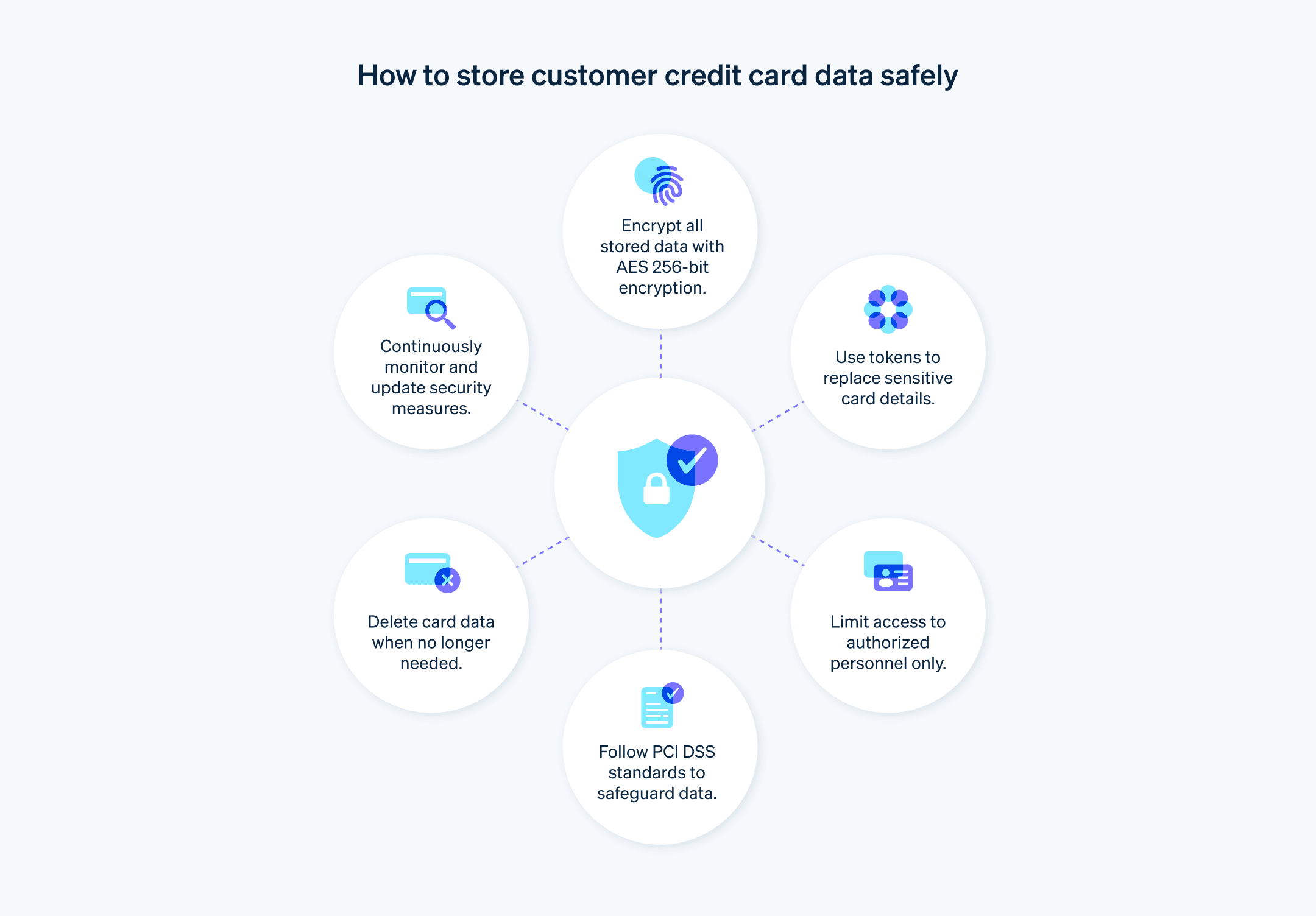几乎所有企业都需要存储客户信用卡信息,但要找到最佳存储方式却并非易事。有关卡片存储的具体要求和规定已经到位,企业必须在不影响客户体验或自身运营效率的情况下保持合规性。信用卡欺诈是一个严重而普遍的问题:以美国为例,65% 的信用卡持有者曾经是欺诈行为的受害者。对于企业而言,安全存储客户卡数据是防止欺诈的重要保障。
下面,我们将介绍支付卡行业数据安全标准(PCI DSS) — 管理客户卡存储的主要安全标准,并概述企业可采用的安全高效地存储客户信用卡信息的最佳实践。
目录
- 银行卡存储如何工作?
- 什么是 PCI DSS?
- 银行卡存储的 PCI 要求
- 银行卡存储的最佳实践
- 存储银行卡的挑战和解决方案
- Stripe 能提供什么帮助
银行卡存储是如何工作的?
银行卡存储是指企业保留客户支付卡信息,包括信用卡和借记卡号码和相关识别细节。企业通常存储的四类数据是持卡人姓名、主帐号 (PAN)、到期日期和服务代码。
企业可以从各种卡存储系统中进行选择,这些系统通常涉及专用数据存储系统、加密和令牌化技术以及数据丢失防护 (DLP) 工具等组件。
什么是 PCI DSS?
PCI DSS 是一套管理企业如何接受、处理、存储和传输信用卡信息的安全标准。该标准保护持卡人数据免遭欺诈和盗窃,任何处理信用卡交易的组织都必须遵守该标准。PCI DSS 由支付卡行业安全标准委员会管理,该委员会由 维萨、万事达、美国运通、发现 和 JCB 等主要信用卡公司成立。遵守 PCI DSS 有助于企业降低数据泄露风险,并确保其银行卡交易安全。
银行卡存储的 PCI 要求
PCI DSS 详细说明了企业在银行卡存储方面的要求,例如:
限制数据存储:仅存储业务需求所需的持卡人数据。授权后不要存储敏感的身份验证数据,即使已经加密。这包括完整磁条、卡验证码或个人识别码 (PIN)/PIN 块等数据。
保护存储的数据:对所有存储的持卡人数据(包括 PAN)进行加密,使用密码学等方法使其在任何地方都无法读取。
限制数据访问:对持卡人数据的访问应仅限于工作需要的个人。实施限制访问的“须知”策略。
创建唯一 ID:为每个可以通过计算机访问持卡人数据的人分配一个唯一的 ID。数据泄露后,这有助于跟踪谁访问了数据。
保护物理位置:保护存储持卡人数据的物理位置。这包括监控、限制访问数据存储区和安全存储系统等措施。
设置保留和处置策略:制定数据保留策略,在不再需要持卡人数据时立即将其删除。删除该类型的数据,并确保其不可恢复。
使用加密密钥:管理和使用强大的加密技术和安全协议,如安全套接字层(SSL)/传输层安全 (TLS) 或互联网协议安全 (IPSEC),以保护敏感的持卡人数据在开放的公共网络传输过程中的安全。
银行卡存储的最佳实践
企业可以通过多种途径来遵守 PCI 合规性要求。这些最佳实践将帮助企业保护其客户的银行卡信息,并以保护用户体验的方式保持 PCI 合规性:
尽量减少持卡人数据的存储:只存储必要的持卡人信息,除非绝对必要,否则避免保留敏感数据。减少存储数据量可以最大限度地降低风险,简化合规工作。
采用高级加密标准 (AES):使用 256 位密钥的 AES 加密存储的持卡人数据。这种方法符合当前的最佳实践,并超越了最低合规性要求。
实施端到端加密 (E2EE):除了基本的加密措施外,还可部署 E2EE,以保护持卡人数据从采集点到安全处理环境的整个过程。
改进访问控制机制:使用多因素身份验证和基于角色的精细访问控制,确保只有授权人员才能访问敏感的持卡人数据,并对所有访问和采取的操作进行清晰的审计跟踪。
集成 DLP 工具:实施 DLP 策略来监视和控制数据传输,防止未经授权的数据泄露,并确保持卡人数据不会被不当存储或分发。
定期进行安全测试:要主动识别和修复潜在的安全漏洞,请执行超出标准 PCI DSS 要求的复杂渗透测试和漏洞评估。
考虑高级令牌化技术:考虑使用动态令牌化(令牌随每次交易而变化),以提供额外的安全保障,并进一步降低截获数据的有用性。
采用自动化合规监控:使用自动化工具持续监控 PCI DSS 标准的合规性,并及时检测和解决任何偏差。
使用零信任架构:采用零信任安全框架,假设所有用户(包括组织内的用户)都可能泄露持卡人数据,并强制执行严格的验证和最小访问原则。
探索抗量子密码学工具:为了防范量子计算带来的新威胁,探索抗量子加密算法的集成。
制定应对计划:制定应对安全事件的计划。如果发生数据泄露,您应该能够快速识别问题,遏制违规行为,并减轻任何潜在的损害。

卡片存储挑战与解决方案
银行卡存储与客户体验的许多方面密切相关,包括如何访问产品和服务,以及内部团队如何管理其与客户数据的交互。即使是设计最完善的卡存储系统,也会产生相当大的复杂性。以下是一些常见的挑战以及解决方案:
可扩展性
- 挑战:随着交易量的增长,保持高性能和 PCI 合规性可能很困难。可扩展性问题可能会影响客户体验和运营效率。
- 解决方案:实施分布式数据库架构,处理高读/写吞吐量,同时保持数据一致性和合规性。使用基于云的弹性解决方案,可根据波动的需求动态扩展,在保持性能的同时不影响安全性。
传统的系统集成
- 挑战:许多组织使用的传统系统在设计上并不符合 PCI DSS 标准。这可能会造成合规性和安全漏洞。
- 解决方案:使用数据抽象层或面向服务的架构对传统系统进行封装,尽量减少对持卡人数据的直接访问。随着时间的推移,考虑使用微服务或容器化来替换传统系统或使其现代化,以提高敏捷性和合规性。
跨境数据隐私
- 挑战:不同地区有不同的数据保护法规,当企业跨境存储持卡人数据时,合规性要求也会提高。
- 解决方案:实施数据驻留解决方案,根据当地法规处理和存储数据。使用基于地理位置的数据存储和处理,根据持卡人的位置并遵守区域合规性要求自动路由和存储数据。
高级安全威胁
- 挑战:由于攻击者的战术不断演变,组织必须与日益复杂的网络攻击和能够绕过传统安全措施的高级持续性威胁 (APT) 作斗争。
- 解决方案:采用分层安全方法,包括先进的威胁检测和响应机制,如人工智能驱动的行为分析,以实时识别和缓解威胁。定期更新事件响应和灾难恢复计划,以应对新型网络威胁。
不断发展的合规标准
- 挑战:PCI DSS 标准和相关监管要求在不断演变,如何保持合规是一项持续的挑战。
- 解决方案:建立持续的合规监控计划,使用自动合规跟踪和报告工具。积极参与积极主动的行业论坛和合作,以领先于新兴标准,并将最佳实践纳入您的合规战略。
数据质量和一致性
Stripe 能提供什么帮助
与 Stripe 合作可以帮助企业减轻 PCI DSS 合规性的负担。通过 Stripe 处理付款,企业无需直接处理敏感的银行卡数据,从而减少了其合规责任的范围。Stripe 是经过认证的 PCI 服务 1 级提供商,这是 PCI 合规性的最高级别,可处理大多数银行卡数据安全任务。这些 Stripe 功能可确保持卡人数据安全,同时帮助企业保持 PCI 合规性:
令牌化:Stripe 的令牌化服务用唯一标识符(令牌)替换敏感的银行卡详细信息,这些标识符可以安全地存储并用于交易,而不会暴露银行卡详细信息。
E2EE:Stripe 对所有敏感数据进行加密,从捕获数据开始,直到在安全环境中处理完毕。这种端到端加密将数据在传输过程中被拦截的风险降至最低。
可扩展性:Stripe 的基础设施建立在一个云平台上,旨在处理大量交易的同时不影响性能。企业可以扩大运营规模,而不必担心遵守合规性和安全标准。
与现代和传统的系统集成: Stripe 提供广泛的应用程序接口 (API) 支持,可轻松与现代和传统系统集成。这种灵活性可帮助企业实现支付处理的现代化,而无需对现有系统进行大修。
持续监控和更新:Stripe 持续监控系统威胁,并定期更新安全措施,以解决新出现的漏洞。安全功能包括机器学习算法,可检测和防止欺诈。
全球合规:Stripe 的业务遍及全球,可以帮助企业处理复杂的数据驻留和跨境地区合规问题。
数据治理:Stripe 的基础架构支持数据完整性和一致性。
依靠 Stripe 管理安全卡存储、数据加密、合规性和可扩展性方面的大部分责任,企业可以将更多时间用于核心业务。进一步了解 Stripe 的安全标准。
本文中的内容仅供一般信息和教育目的,不应被解释为法律或税务建议。Stripe 不保证或担保文章中信息的准确性、完整性、充分性或时效性。您应该寻求在您的司法管辖区获得执业许可的合格律师或会计师的建议,以就您的特定情况提供建议。